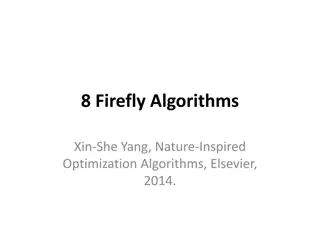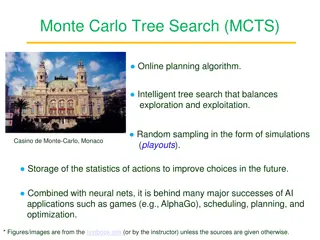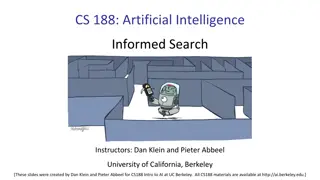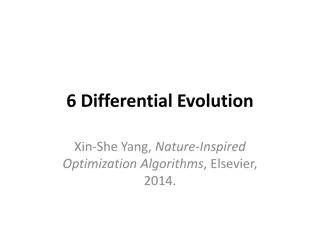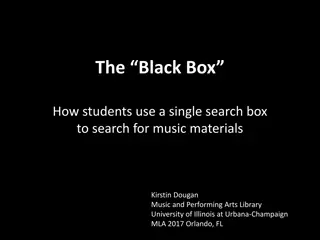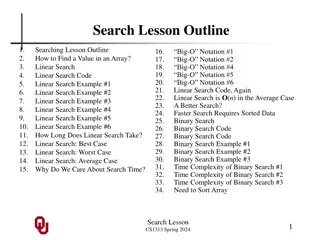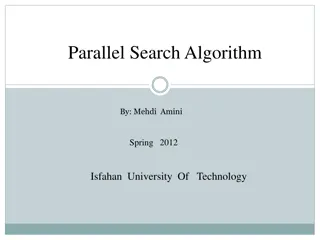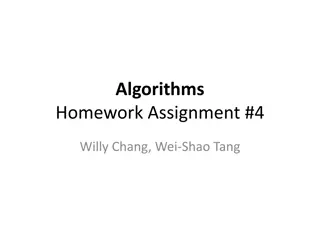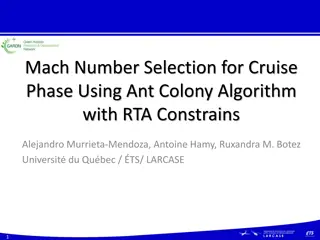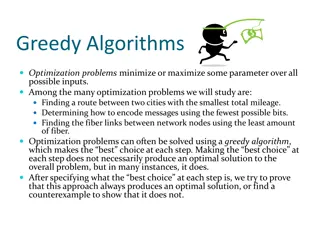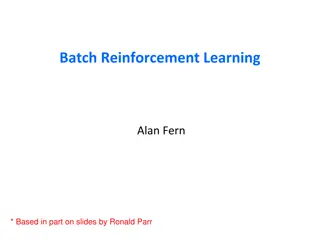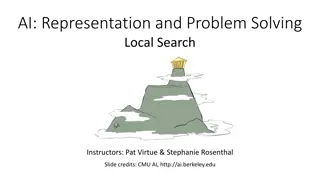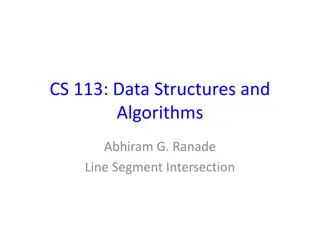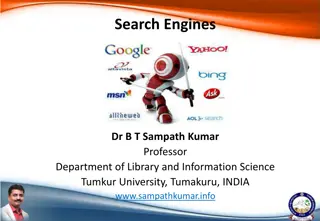Cuckoo Search: A Nature-Inspired Optimization Algorithm
Cuckoo Search (CS) algorithm, developed in 2009, mimics the brood parasitism of cuckoo species and utilizes Lévy flights for efficient optimization. This algorithm has shown promise in outperforming other traditional methods like PSO and genetic algorithms. The behavior of cuckoos in laying eggs and evicting host eggs is a key aspect of this optimization technique, along with the implementation of idealized rules. The utilization of Lévy flights in searching for optimal solutions further enhances the algorithm's performance.
Download Presentation

Please find below an Image/Link to download the presentation.
The content on the website is provided AS IS for your information and personal use only. It may not be sold, licensed, or shared on other websites without obtaining consent from the author. Download presentation by click this link. If you encounter any issues during the download, it is possible that the publisher has removed the file from their server.
E N D
Presentation Transcript
9 Cuckoo Search Xin-She Yang, Nature-Inspired Optimization Algorithms, Elsevier, 2014.
Cuckoo search (CS) is developed in 2009 by Xin- She Yang of Cambridge University and Suash Deb of C.V. Raman College of Engineering. CS is based on the brood parasitism of some cuckoo species. In addition, this algorithm is enhanced by the so- called L vy flights rather than by simple isotropic random walks. Recent studies show that CS is potentially far more efficient than PSO, genetic algorithms, and other algorithms.
9.1 Cuckoo Breeding Behavior Quite a number of cuckoo species engage in obligate brood parasitism by laying their eggs in the nests of other host birds (often other species). There are three basic types of brood parasitism: Intraspecific brood parasitism Cooperative breeding Nest takeover
Specialized in mimicry in color and pattern of the eggs of a few chosen host species. Parasitic cuckoos often choose a nest where the host bird just laid its own eggs. In general, the cuckoo eggs hatch slightly earlier than their host eggs. Once the first cuckoo chick is hatched, the first instinct action it will take is to evict the host eggs by blindly propelling the eggs out of the nest.
9.2 Lvy Flights Various studies have shown that flight behavior of many animals and insects has demonstrated the typical characteristics of L vy flights with power law-like characteristics. Subsequently, such behavior has been applied to optimization and optimal search, and results show its promising capability
9.3 Cuckoo Search For simplicity in describing the standard CS, here we use the following three idealized rules: Each cuckoo lays one egg at a time and dumps it in a randomly chosen nest. The best nests with high-quality eggs will be carried over to the next generations. The number of available host nests is fixed, and the egg laid by a cuckoo is discovered by the host bird with a probability pa (0, 1). In this case, the host bird can either get rid of the egg or simply abandon the nest and build a completely new nest.
As a further approximation, this last assumption can be approximated by replacing a fraction paof the n host nests with new nests (with new random solutions). From the implementation point of view, we can use the following simple representations that each egg in a nest represents a solution, and each cuckoo can lay only one egg (thus representing one solution).
The aim is to use the new and potentially better solutions (cuckoos) to replace a not-so- good solution in the nests. Here we use the simplest approach, where each nest has only a single egg. In this case, there is no distinction between an egg, a nest, or a cuckoo, since each nest corresponds to one egg, which also represents one cuckoo.
The updating Eq. (9.2) is essentially a stochastic equation for a random walk. In general, a random walk is a Markov chain whose next state/location depends only on the current location (the first term in the preceding equation) and the transition probability (the second term). However, a substantial fraction of the new solutions should be generated by far field randomization, and their locations should be far enough from the current best solution; this will make sure that the system will not be trapped in a local optimum [30,32].
9.3.1 Special Cases of Cuckoo Search Therefore, differential evolution, PSO, and SA can be considered special cases of the cuckoo search algorithm. Conversely, we can say that CS is a good and efficient combination of DE, PSO, and SA in one algorithm.
9.3.2 How to Carry Out Lvy Flights From the implementation point of view, the generation of random numbers with L vy flights consists of two steps: The choice of a random direction The generation of steps that obey the chosen L vy distribution. The generation of a direction should be drawn from a uniform distribution, whereas the generation of steps is quite tricky.
9.3.4 Variants of Cuckoo Search Quantum cuckoo search (QCS). A variant of CS by adding quantum behavior to the algorithm. Discrete cuckoo search (DCS). Multi-objective cuckoo search (MOCS). Discrete multi-objective cuckoo search (DMOCS). Hybrid cuckoo search (HCS).
9.4 Why Cuckoo Search is so Efficient It has been proved that cuckoo search can satisfy the global convergence requirements and thus has guaranteed global convergence properties [27].
Furthermore, cuckoo search has two search capabilities: local search and global search, controlled by a switching/discovery probability. As mentioned in the previous section, the local search is very intensive, with about 1/4 of the search time (for pa=0.25), whereas global search takes about 3/4 of the total search time. This allows that the search space can be explored more efficiently on a global scale, and consequently the global optimality can be found with a higher probability.
A further advantage of CS is that its global search uses L vy flights or process rather than standard random walks. Because L vy flights have infinite mean and variance, CS can explore the search space more efficiently than algorithms using standard Gaussian processes. This advantage, combined with both local and search capabilities and guaranteed global convergence, makes CS very efficient.



